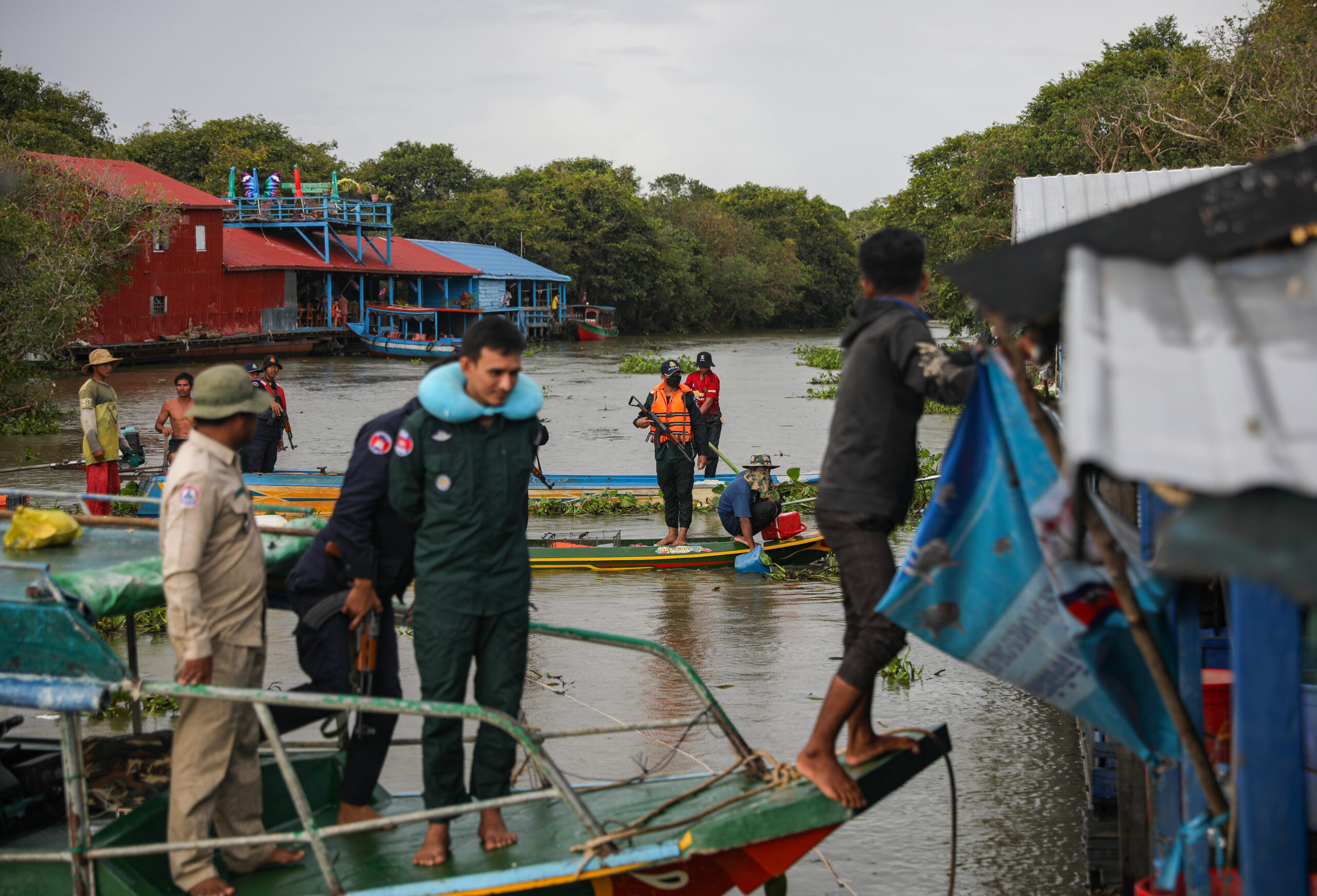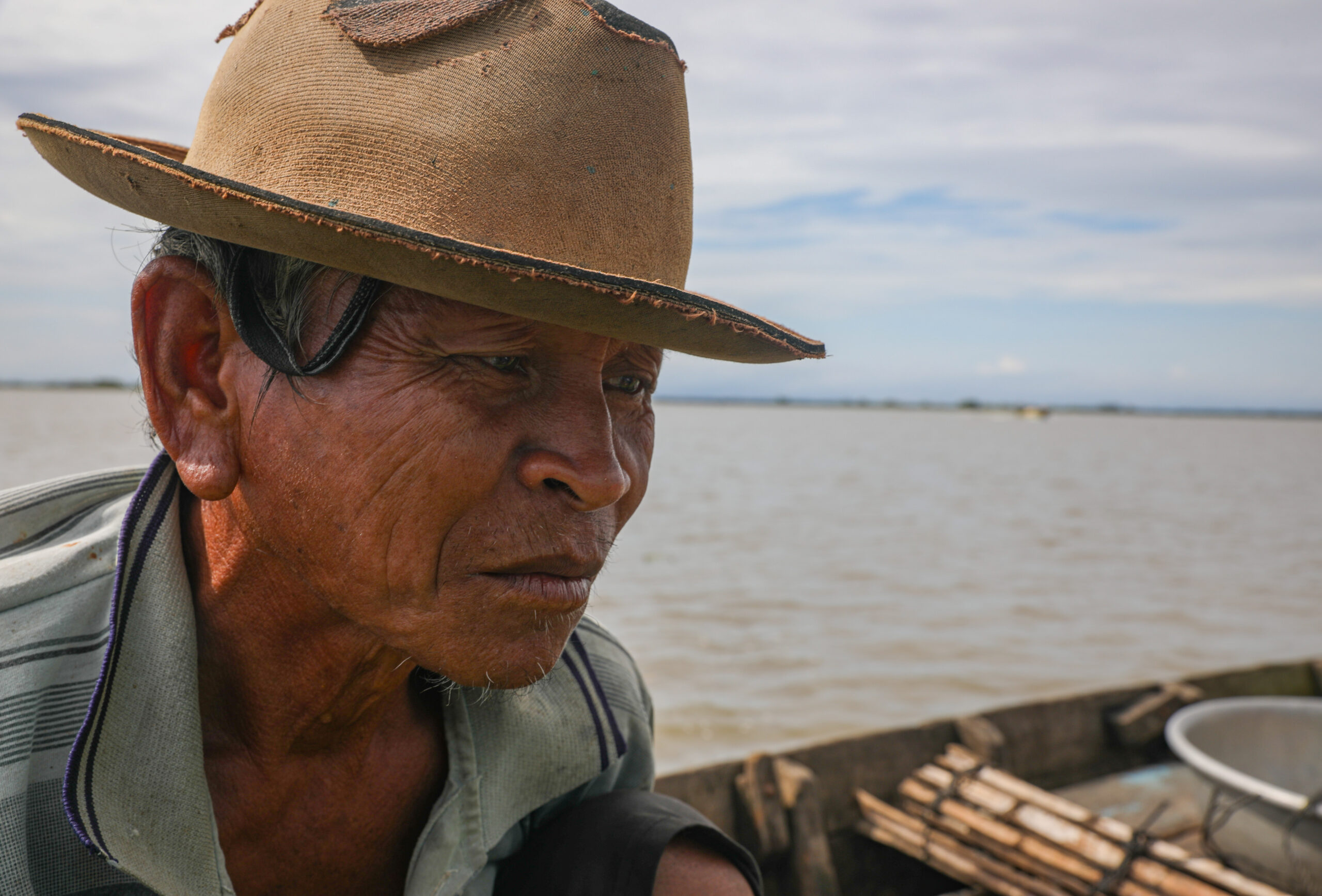Like her parents and grandparents, Thi Bay has made a living from fishing on Cambodia’s Tonle Sap Lake her whole life. But the combination of a collapsing ecosystem and ever-changing management is forcing the 70-year-old to leave fishing behind.
Instead, Thi Bay now spends several days a week collecting snails on the outskirts of her village, Chong Kneas, one of several houseboat communities along the banks of Southeast Asia’s largest freshwater lake. She mostly sells the snails to locals, who like to buy directly from fishers to ensure the freshest produce. Even still, this barely supports her and her granddaughter, Thi Bay said as she plucked another snail from her trap, which she’d fashioned from submerged branches.
“I prefer to fish. Nobody buys snails every day,” she said. But in the face of an ongoing crackdown on illegal fishing on the lake – and constantly changing rules around what is allowed, and where – she doesn’t dare go fishing. “We are in trouble if we do anything illegal. But even if I am not guilty, I don’t want to risk it.”


After a life of fishing, Tang Thi Bay has transitioned to collecting snails, following a sudden policy change on Tonle Sap Lake. “I have not been on the lake for many days. But when I am, I just collect the snails,” she said.
The rules and regulations around fishing on the Tonle Sap – the seasonal flooding of which is often referred to as the ‘beating heart of the Mekong’ – have swung on a political pendulum over the past decade. Many of these changes have coincided with Cambodia’s election cycles at the national and commune levels.
In the run-up to a 2012 election, Cambodian Prime Minister Hun Sen dissolved a century-old privatised fishing model in a populist bid that opened the lake to all.
But a decade later, with international partners such as the European Union investing upwards of $100 million dollars to revamp Cambodia’s fisheries sector, Hun Sen announced a crackdown on illegal fishing on Tonle Sap, lurching back to more restrictive management. Officially, the crackdown was only meant to affect those practising illegal methods, such as electrofishing, which uses electric currents to stun fish.

However, the gusto with which these orders have been enforced has scared off many other fishers, including Thi Bay, while fines and equipment confiscations have left residents of the lake’s floating villages struggling to find new livelihoods.
‘Let the people be the owner’
Fishing lots have existed on Tonle Sap in various forms since at least the 1880s. The general premise of a lot is simple: Only the lot owner can fish within that designated area during a specific season.



Boatman Meas Sareth paddles through the heart of Kampong Phluk, a floating village on Cambodia’s Tonle Sap Lake
In the more modern system, which was re-established in the late 1980s during Cambodia’s civil conflict, lot ownership and licences were auctioned to the highest bidder for thousands of dollars.
A 2007 study found that this system often deepened inequalities between lot owners and other fishers, causing conflicts over access. But this highly exclusive system limited the number of fishers active on the lake and safeguarded spawning areas, thereby limiting pressure on the lake’s natural resources.
In the floating village of Kampong Khleang, not far from where Thi Bay was collecting snails, fisherman Chhong Pov sells his daily catch for less than 3,000 Cambodian riel, barely $0.70. Having fished on Tonle Sap for nearly 50 years, Pov has witnessed half a century of back-and-forth management on the lake.
With his daily income in hand, on a recent morning he pointed his boat back towards home and muttered: “I don’t know where the fish are going, but they are gone.”
“When there was a lot system, I could earn more because people protected the lot,” continued Pov. “Even if the lot owner decided to take the fish out, there was still fish left because the remaining fish spawned inside the lot and swam out. There could be boatloads of fish.”


With his daily income in hand and a few fish for his family below deck, Chhong Pov ends another day’s fishing on Tonle Sap Lake. Pov has fished through nearly 50 years of back-and-forth management on Cambodia’s great lake
This was until 2012, when Hun Sen abolished Tonle Sap’s last fishing lots – which at the time covered nearly 600 square kilometres. Several lots had been dissolved prior to this final order.
“Lot owners may be angry at me but I do not care about those who benefit. What matters to me is the Cambodian people receive the benefit,” said Hun Sen at the time.
According to a 2015 study on the fallout of this move, former lot owners said that “the government had manipulated access to resources to pacify the fishermen in exchange for votes.”
A report by the International Union for the Conservation of Nature a year later found that in the aftermath of the lots being dissolved, “no steps were taken to prepare or reinforce communities or governments in order to avoid a ‘tragedy of the commons’ whereby inequitable but well managed fishing lots were replaced by a free for all.”
The pressure created by this open access added to a number of severe threats already facing Tonle Sap’s fisheries, including the impacts of hydropower development and climate change.

A record-breaking drought in the lower Mekong River basin between 2019 and 2021 showcased the devastating effects of these compounding factors. The Mekong’s water flow hit record lows in this period, hitting fisheries in the river and Tonle Sap hard. Cambodia’s Fisheries Administration recorded drops in fish production across the country.


So Phann, who buys fish directly from Tonle Sap Lake fishers to sell in wet markets in Siem Reap City, said she has witnessed steady declines in both fish abundance and size over the last five to 10 years
Experts attributed the cause of the drought to hydroelectric dams upstream withholding water, as well as low and erratic rainfall during the wet season. A 2021 report from the Mekong River Commission noted that “climate change and the El Nino event are likely to have contributed to the delayed and reduced monsoon rain” in 2021. The drought followed a historic wildfire season in 2018 that scorched hundreds of thousands of acres of the lake’s flooded forests.
Crackdowns drive tensions
In March 2022, Hun Sen ordered a crackdown on illegal fishing and logging on and near Tonle Sap, leading to regulatory changes around fishing locations and the type of equipment allowed.
Long Senhout, an official with the Ministry of Environment stationed near Kampong Khleang, said funding for local law enforcement was also increased, and more consistent patrolling was approved.


The eager enforcement of this new order has strained relationships with local communities, Senhout said. “It is hard for them because they got used to the larger lot system, then they got used to not having it, and now they are getting used to new rules. People are not really happy.”

“The rules keep changing and the fish keep getting smaller, but what choice is there?” said Chhong Pov, who unlike Thi Bay, sees no alternative to fishing. “I am a fisherman, I must fish.”
Residents of floating villages along the shores of Tonle Sap, like Chhong Pov, say the crackdown has left fishers operating both legally and illegally terrified of fines and arrests. But with few options for alternative livelihoods around the villages, Pov said he chooses food over fear.
Efforts to revive the Tonle Sap fisheries

In March 2022, Wonders of the Mekong, a research project funded by the US Agency for International Development, released nearly 1,600 fish – all threatened species – into the Tonle Sap, in an attempt to bolster wild populations. The organisation plans to release 5,000 more fish in mid-January in the Tonle Sap River in Phnom Penh.
“We know this fishery is under pressure. We know that regulations have changed in the last 10 years to really open up this area to a lot more fishermen than may have previously been in the system,” said Elizabeth Everest, a Wonders of the Mekong researcher. “I don’t know when the particular year is when things will be at a point of no return. But in the research community, there is a lot of concern for the area.”



Wonders of the Mekong conducted its largest ever fish release on Tonle Sap Lake in March 2022
Hoy Sreynov, an officer in the Cambodian Fisheries Administration’s Department of Aquaculture Development, manages the ponds where threatened fish are raised for release. She said this process increases the chances for endangered species in the wild, and helps safeguard Tonle Sap’s key role in seasonal fish migration up and down stream.
‘I gave up and changed my occupation’
Across the lake from Chhong Pov and Thi Bay, in the floating village of Kampong Luong, Chum Sreynga is tending to her floating garden.
“My occupation was fishing, but fishing is not good,” said Sreynga. “The lake is almost completely empty. So, I gave up and changed my occupation [to growing vegetables].”


Chum Sreynga owns and operates the largest floating garden in Kampong Luong, a floating village on the southern side of Cambodia’s Tonle Sap Lake. She switched from fishing after yields fell.
Chum’s is one of 12 former fishing families who are experimenting with floating gardens in Kampong Luong, with the support of the charity Voluntary Services Overseas and CAPFISH, a multi-million-dollar European Union initiative attempting to revamp Cambodia’s fisheries sector and aid those attempting to find sustainable alternative livelihoods to fishing.

The search for alternative livelihoods is only becoming more desperate as Tonle Sap’s ecosystem buckles under the pressures of human activity and politics, perhaps spelling an end to a way of life on Cambodia’s great lake.
“I decided to grow vegetables because I wanted to have something to eat,” Sreynga said. “The fish are declining but I have a business that can sustain my living so I don’t care now. I had to move on.”
Photos by Anton L. Delgado for Southeast Asia Globe. Additional reporting by Sophanna Lay
This story was produced in collaboration with The Third Pole


